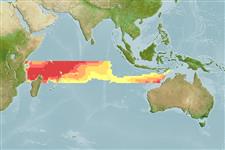Actinopterígios (peces con aletas radiadas) >
Myctophiformes (Lanternfishes) >
Myctophidae (Lanternfishes) > Lampanyctinae
Etymology: Diaphus: Greek, dis, dia = through + Greek, physa, phyo = to beget, to have as offspring (Ref. 45335).
Medioambiente / Clima / Gama
Ecología
; marino batipelágico; oceanodromo (Ref. 51243); rango de profundidad ? - 500 m (Ref. 4066). Deep-water, preferred ?; 4°S - 17°S
Western Indian Ocean: 04°-12°S, 40°-65°E. Eastern Indian Ocean: 17°02'S, 94°50'E.
Tamaño / Peso / Age
Maturity: Lm ? range ? - ? cm
Max length : 5.5 cm SL macho / no sexado; (Ref. 4066)
Espinas dorsales (total): 0; Radios blandos dorsales (total): 14-15; Espinas anales 0; Radios blandos anales: 15 - 17
Oceanic and mesopelagic, found in the upper 500 m at night.
Life cycle and mating behavior
Madurez | Reproducción | Puesta | Huevos | Fecundidad | Larva
Hulley, P.A., 1986. Myctophidae. p. 282-321. In M.M. Smith and P.C. Heemstra (eds.) Smiths' sea fishes. Springer-Verlag, Berlin. (Ref. 4066)
IUCN Red List Status (Ref. 115185)
CITES (Ref. 94142)
Not Evaluated
Threat to humans
Harmless
Human uses
Más información
Age/SizeCrecimientoLength-weightLength-lengthLength-frequenciesMorfometríaMorfologíaLarvaDinámica larvariaReclutamientoAbundancia
ReferenciasAcuiculturaPerfil de acuiculturaRazasGenéticaFrecuencias de alelosheritabilidadEnfermedadesProcesamientoMass conversion
ColaboradoresImágenesStamps, CoinsSonidosCiguateraVelocidadTipo de nataciónSuperficie branquialOtolitosCerebrosVisión
Herramientas
Special reports
Download XML
Fuentes de Internet
